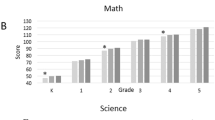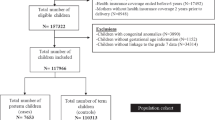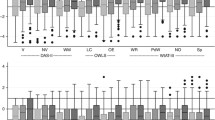Abstract
The developmental outcomes for children born preterm have been examined by many, with results unequivocally indicating that children born preterm tend to have poorer cognitive outcomes and more developmental difficulties. Less attention has been paid to academic outcomes. The purpose of this paper is to review the academic skills assessment of children born preterm, examine the methodologies used to ascertain skill deficits, and identify essential directions for future research. Overwhelmingly the results of studies of academic skills indicate that children born preterm function lower than their full term peers. The methodological flaws with existing studies that impede broad conclusions about specific skill deficits will be discussed. It is critical that future research examine the academic skill deficits contributing to disability status so that effective early intervention strategies may be developed and implemented.
Similar content being viewed by others
References
Aarnoudse-Moens, C. S. H., Weisglas-Kuperus, N., van Goudoever, J. B., & Oosterlaan, J. (2009). Meta-analysis of neurobehavioral outcomes in very preterm and/or very low birth weight children. Pediatrics, 124(2), 717–728.
Anderson, P. J., & Doyle, L. W. (2004). Executive functioning in school-aged children who were born very preterm or with extremely low birth weight in the 1990s. Pediatrics, 114(1), 50–57.
*Anderson, P. J., Doyle, L. W., Callanan, C., Carse, E., Casalaz, D., Charlton, M. P., et al. (2003). Neurobehavioral outcomes of school-age children born extremely low birth weight or very preterm in the 1990 s. JAMA: Journal of the American Medical Association, 289(24), 3264–3272. doi:10.1001/jama.289.24.3264.
Arpino, C., Compagnone, E., Montanaro, M. L., Cacciatore, D., De Luca, A., Cerulli, A., et al. (2010). Preterm birth and neurodevelopmental outcome: a review. Child’s Nervous System. doi: 10.1007/s00381-010-1125-y.
Aylward, G. P. (2002a). Cognitive and neuropsychological outcomes: More than IQ scores. Mental Retardation and Developmental Disabilities Research Reviews, 8(4), 234–240. doi:10.1002/mrdd.10043.
Aylward, G. P. (2002b). Methodological issues in outcome studies of at-risk infants. Journal of Pediatric Psychology, 27(1), 37–45. doi:10.1093/jpepsy/27.1.37.
Aylward, G. P. (2009). Neonatology, prematurity, and developmental issues. In M. C. Roberts & R. G. Steele (Eds.), Handbook of pediatric psychology (4th ed., pp. 241–253). New York, NY: Guilford Press.
Baron, I., & Rey-Casserly, C. (2010). Extremely preterm birth outcome: A review of four decades of cognitive research. Neuropsychology Review, 20(4), 430–452. doi:10.1007/s11065-010-9132-z.
Beck, S., Wojdyla, D., Say, L., Betran, A. P., Merialdi, M., Requejo, J. H., et al. (2010). The worldwide incidence of preterm birth: a systematic review of maternal mortality and morbidity. Bulletin of the World Health Organization, 88(1), 31–38. doi:10.2471/blt.08.062554.
*Bowen, J. R., Gibson, F. L., & Hand, P. J. (2002). Educational outcome at 8 years for children who were born extremely prematurely: A controlled study. Journal of Paediatrics and Child Health, 38(5), 438–444. doi:10.1046/j.1440-1754.2002.00039.x.
*Breslau, N., Johnson, E. O., & Lucia, V. C. (2001). Academic achievement of low birthweight children at age 11: The role of cognitive abilities at school entry. Journal of Abnormal Child Psychology: An official publication of the International Society for Research in Child and Adolescent Psychopathology, 29(4), 273–279. doi:10.1023/a:1010396027299.
*Chyi, L. J., Lee, H. C., Hintz, S. R., Gould, J. B., & Sutcliffe, T. L. (2008). School outcomes of late preterm infants: Special needs and challenges for infants born at 32–36 weeks gestation. The Journal of Pediatrics, 153(1), 25–31. doi:10.1016/j.jpeds.2008.01.027.
*Downie, A. L. S., Frisk, V., & Jakobson, L. S. k. (2005). The impact of periventricular brain injury on reading and spelling abilities in the late elementary and adolescent years. Child Neuropsychology, 11(6), 479–495. doi:10.1080/09297040591001085.
Fletcher, J. M., Lyon, G. R., Fuchs, L., & Barnes, M. (2007). Learning disabilities: From identification to intervention. New York, NY: Guilford Press.
Frye, R. E., Landry, S. H., Swank, P. R., & Smith, K. E. (2009). Executive dysfunction in poor readers born prematurely at high risk. Developmental Neuropsychology, 34(3), 254–271. doi:10.1080/87565640902805727.
Goyen, T.-A., Lui, K., & Woods, R. (1998). Visual-motor, visual-perceptual, and fine motor outcomes in very-low-birthweight children at 5 years. Developmental Medicine and Child Neurology, 40(2), 76–81.
*Gross, S. J., Mettelman, B. B., Dye, T. D., & Slagle, T. A. (2001). Impact of family structure and stability on academic outcome in preterm children at 10 years of age. The Journal of Pediatrics, 138(2), 169–175.
*Grunau, R. E., Whitfield, M. F., & Davis, C. (2002). Pattern of learning disabilities in children with extremely low birth weight and broadly average intelligence. Archives of Pediatrics and Adolescent Medicine, 156(6), 615–620.
*Hack, M., Taylor, H. G., Drotar, D., Schluchter, M., Cartar, L., Wilson-Costello, D., et al. (2005). Poor predictive validity of the Bayley scales of infant development for cognitive function of extremely low birth weight children at school age. Pediatrics, 116(2), 333–341.
Individuals with Disabilities Education Improvement Act of 2004 (Public Law 108–446).
Jastak, S., & Wilkinson, G. (1984). Wide range achievement test-revised. Wilmington, DE: Jastak Associates.
Johnson, E. O., & Breslau, N. (2000). Increased risk of learning disabilities in low birth weight boys at age 11 years. Biological Psychiatry, 47(6), 490–500.
*Johnson, S., Hennessy, E., Smith, R., Trikic, R., Wolke, D., & Marlow, N. (2009). Academic attainment and special educational needs in extremely preterm children at 11 years of age: the EPICure study. Archives of Disease in Childhood. Education and Practice Edition, 94(4), F283–F289. doi:10.1136/adc.2008.152793.
Johnson, S., Hollis, C., Kochhar, P., Hennessy, E., Wolke, D., & Marlow, N. (2010). Autism spectrum disorders in extremely preterm children. Journal of Pediatrics, 156(4), 525–531. e522.
Johnson, S., Wolke, D., & Marlow, N. (2008). Outcome monitoring in preterm populations: Measures and methods. Zeitschrift für Psychologie/Journal of Psychology, 216(3), 135–146. doi:10.1027/0044-3409.216.3.135.
Kalia, J. L., Visintainer, P., Brumberg, H. L., Pici, M., & Kase, J. (2009). Comparison of enrollment in interventional therapies between late-preterm and very preterm infants at 12 months’ corrected age. Pediatrics, 123(3), 804–809.
*Kan, E., Roberts, G., Anderson, P. J., & Doyle, L. W. (2008). The association of growth impairment with neurodevelopmental outcome at 8 years of age in very preterm children. Early Human Development, 84(6), 409–416. doi:10.1016/j.earlhumdev.2007.11.002.
Klebanov, P. K., Brooks-Gunn, J., & McCormick, M. C. (1994). School achievement and failure in very low birth weight children. Journal of Developmental and Behavioral Pediatrics, 15(4), 248–256.
*Litt, J., Taylor, H. G., Klein, N., & Hack, M. (2005). Learning disabilities in children with very low birthweight: Prevalence, neuropsychological correlates, and educational interventions. Journal of Learning Disabilities, 38(2), 130–141. doi:10.1177/00222194050380020301.
Marlow, N., Wolke, D., Bracewell, M. A., & Samara, M. (2005). Neurologic and developmental disability at 6 years of age after extremely preterm birth. The New England Journal of Medicine, 352(1), 9–19. doi:10.1056/NEJMoa041367.
Martin, A., Brooks-Gunn, J., Klebanov, P., Buka, S. L., & McCormick, M. C. (2008). Long-term maternal effects of early childhood intervention: Findings from the Infant Health and Development Program (IHDP). Journal of Applied Developmental Psychology, 29(2), 101–117. doi:10.1016/j.appdev.2007.12.007.
*McGrath, M., & Sullivan, M. (2002). Birth weight, neonatal morbidities, and school age outcomes in full-term and preterm infants. Issues in Comprehensive Pediatric Nursing, 25(4), 231–254. doi:10.1080/01460860290042611.
Morse, S. B., Zheng, H., Tang, Y., & Roth, J. (2009). Early school-age outcomes of late preterm infants. Pediatrics, 123(4), e622–e629. doi:10.1542/peds.2008-1405.
Msall, M. E., Buck, G. M., Rogers, B. T., Merke, D., Catanzaro, N. L., & Zorn, W. A. (1991). Risk factors for major neurodevelopmental impairments and need for special education resources in extremely premature infants. The Journal of Pediatrics, 119(4), 606–614.
*Pritchard, V. E., Clark, C. A. C., Liberty, K., Champion, P. R., Wilson, K., & Woodward, L. J. (2009). Early school-based learning difficulties in children born very preterm. Early Human Development, 85(4), 215–224. doi:10.1016/j.earlhumdev.2008.10.004.
Roberts, G., Howard, K., Spittle, A. J., Brown, N. C., Anderson, P. J., & Doyle, L. W. (2008). Rates of early intervention services in very preterm children with developmental disabilities at age 2 years. Journal of Paediatrics and Child Health, 44(5), 276–280. doi:10.1111/j.1440-1754.2007.01251.x.
Roth, J., Figlio, D. N., Chen, Y., Ariet, M., Carter, R. L., Resnick, M. B., et al. (2004). Maternal and infant factors associated with excess kindergarten costs. Pediatrics, 114(3), 720–728.
*Saigal, S., den Ou, L., Wolke, D., Hoult, L., Paneth, N., Streiner, D. L., et al. (2003). School-age outcomes in children who were extremely low birth weight from four international population-based cohorts. Pediatrics, 112(4), 943–950.
Saigal, S., & Doyle, L. W. (2008). An overview of mortality and sequelae of preterm birth from infancy to adulthood. Lancet, 371(9608), 261–269.
Salt, A., & Redshaw, M. (2006). Neurodevelopmental follow-up after preterm birth: Follow up after 2 years. Early Human Development, 82(3), 185–197. doi:10.1016/j.earlhumdev.2005.12.015.
Sattler, J. M. (2008). Assessment of children: Cognitive foundations (5th ed.). La Mesa, CA: Jerome M. Sattler.
*Short, E. J., Klein, N. K., Lewis, B. A., Fulton, S., Eisengart, S., Kercsmar, C., et al. (2003). Cognitive and academic consequences of bronchopulmonary dysplasia and very low birth weight: 8-year-old outcomes. Pediatrics, 112(5), e359–e366.
*Sullivan, M. C., & McGrath, M. M. (2003). Perinatal morbidity, mild motor delay, and later school outcomes. Developmental Medicine and Child Neurology, 45(2), 104–112. doi:10.1017/s0012162203000203.
*Taylor, H. G., Burant, C. J., Holding, P. A., Klein, N., & Hack, M. (2002). Sources of variability in sequelae of very low birth weight. Child Neuropsychology, 8(3), 163–178. doi:10.1076/chin.8.3.163.13500.
Taylor, H. G., Espy, K. A., & Anderson, P. J. (2009). Mathematics deficiencies in children with very low birth weight or very preterm birth. Developmental Disabilities Research Review, 15(1), 52–59. doi:10.1002/ddrr.51.
*Taylor, H. G., Klein, N., Drotar, D., Schluchter, M., & Hack, M. (2006). Consequences and risks of <1000-g birth weight for neuropsychological skills, achievement, and adaptive functioning. Journal of Developmental and Behavioral Pediatrics, 27(6), 459–469. doi:10.1097/00004703-200612000-00002.
Taylor, H. G., Klein, N., & Hack, M. (2000). School-age consequences of birth weight less than 750 g: A review and update. Developmental Neuropsychology, 17(3), 289–321. doi:10.1207/s15326942dn1703.
*Taylor, H. G., Klein, N., Minich, N. M., & Hack, M. (2000). Middle-school-age outcomes in children with very low birthweight. Child Development, 71(6), 1495–1511. doi:10.1111/1467-8624.00242.
Tucker, J., & McGuire, W. (2004). ABC of preterm birth: Epidemiology of preterm birth. first in a series of 12 articles. BMJ: British Medical Journal, 329(7467), 675–678.
Tyson, J. E., & Saigal, S. (2005). Outcomes for extremely low-birth-weight infants: Disappointing news. JAMA: Journal of the American Medical Association, 294(3), 371–373.
Wechsler, D. (2001). Wechsler individual achievement test (2nd ed.). San Antonio, TX: Pearson.
*Wocadlo, C., & Rieger, I. (2006). Educational and therapeutic resource dependency at early school-age in children who were born very preterm. Early Human Development, 82(1), 29–37. doi:10.1016/j.earlhumdev.2005.06.005.
Woodcock, R. W., McGrew, K. S., & Mather, M. (2001). Woodcock-Johnson III tests of achievement. Itasca, IL: Riverside Publishing.
Xu, Y., & Filler, J. W. (2005). Linking assessment and intervention for developmental/functional outcomes of premature, low-birth-weight children. Early Childhood Education Journal, 32(6), 383–389. doi:10.1007/s10643-005-0008-4.
Author information
Authors and Affiliations
Corresponding author
Rights and permissions
About this article
Cite this article
Keller-Margulis, M., Dempsey, A. & Llorens, A. Academic Outcomes for Children Born Preterm: A Summary and Call for Research. Early Childhood Educ J 39, 95–102 (2011). https://doi.org/10.1007/s10643-011-0446-0
Published:
Issue Date:
DOI: https://doi.org/10.1007/s10643-011-0446-0




